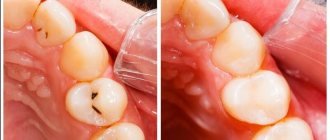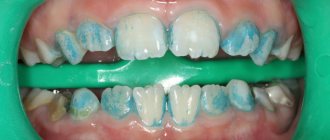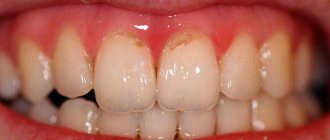Dental caries is one of the most common diseases. It is rare to meet a person who has never visited a dentist in his life and has not complained of toothache. Thanks to the intensive development of dentistry, this disease is successfully treated, but doctors cannot yet prevent its occurrence.
How does tooth decay affect teeth?
Tooth enamel is the hardest tissue of the human body. Despite its high strength and hardness characteristics, it cannot resist the carious process. This is a dental disease that slowly destroys tooth tissue - enamel and dentin.
The occurrence of caries is associated with the activity of bacteria that live in the oral cavity and form a biofilm on the teeth. The same plaque that we remove every day when brushing our teeth is nothing more than a collection of bacteria. The microflora of the oral cavity consists of different microorganisms, but not all of them contribute to the development of caries. Scientists have proven that the most significant role in the destruction of tooth enamel and dentin belongs to bacteria of the genus Streptococcus mutans. In this case, it is not the bacteria themselves that have a damaging effect, but their metabolic products - lactic and other organic acids. Bacteria produce them during the processing of carbohydrates, or more precisely, the fermentation of the sugars they contain.
The common belief that tooth decay occurs from sweets is only partly true. Eating carbohydrate foods actually creates favorable conditions for bacteria in the oral cavity and promotes increased production of acids. But dentists note that the danger is not the very fact of consuming sugar and carbohydrate products, but the frequency of food intake and the duration of its stay in the oral cavity. A large number of snacks on sweet foods, sucking candies that can remain in the mouth for up to half an hour, neglect of the rules of brushing teeth.
The longer plaque on teeth comes into contact with carbohydrate foods, the higher the risk of developing caries. That is why dentists recommend reducing the number of snacks, rinsing your mouth after each meal, not eating sweets before bed after brushing your teeth, and giving children plain water at night instead of compotes or sweet formula.
Features of the structure of teeth
A tooth is a formation of hard tissue, which differs in structure from other bones, since it is a derived part of the mucosa. The teeth are attached to the bone sockets - alveoli, which are located on the lower and upper jaws. There are 4 types of teeth: molars, premolars, canines and incisors. The first and second ones are for chewing, and the third and fourth ones are for biting food.
Each tooth consists of a root, which is located in the alveolus, a neck, a main part and a crown. Inside the hard tissues, or dentin, there are vessels, capillaries and pulp, they supply the tooth with oxygen and other nutrients.
Dentin is covered with tooth enamel, which protects hard tissues from environmental factors. Caries forms on the enamel, after which it penetrates into the tooth and destroys it. Let's take a closer look at how a carious cavity is formed.
What process is called initial caries?
There is a popular belief that only when there is a hole in the tooth is it caries. In fact, the carious process is characterized by a sluggish and relatively slow course. And the first signs of the disease appear much earlier than a hole (carious cavity) appears in the tooth. Acids produced by bacteria gradually destroy the layers of the tooth, and it can take several years from initial caries to its advanced stage. Depending on how deeply the carious process has affected the dental tissues, the disease is divided into four main stages: stain stage, superficial, medium and deep caries.
The stain stage is called initial caries, and at this stage there is no cavity in the tooth, only a light, barely noticeable stain on the surface of the enamel. It represents a site of demineralization - that is, a zone in which the enamel loses its strength characteristics due to the loss of minerals.
Initial caries has the most favorable prognosis compared to other stages. In most cases, it is reversible and can be treated without drilling or filling the tooth. The difficulty is that it is very difficult to detect the carious process at this stage, because it has almost no clinical manifestations. Pain, discomfort while eating, reaction to cold and hot, darkening of the tooth, food getting stuck in the carious cavity - all these symptoms are absent with initial dental caries. A dentist can detect it during a routine examination, which is why it is so important to visit a doctor even if there are no complaints. If measures were not taken at the initial stage to stop the carious process, it will progress to other stages.
Superficial caries is characterized by unpleasant sensations while eating and the formation of a carious cavity in the tooth enamel. Medium and deep are forms of caries in which destruction has affected dentin tissue. Deep caries is especially dangerous, in this case the destruction comes close to the dental nerve. Such caries is often complicated by pulpitis and periodontitis. It is better not to start the process until the stage of medium and especially deep caries, but to treat it at an early stage.
Types of caries by location
The cause of caries is often indicated by its location. Caries is classified according to location:
- Fissure . Develops on fissures - pits and depressions of the chewing surfaces of molars. In the depressions, food debris is retained and microorganisms multiply. The maturation of enamel, which begins from the moment teeth erupt, occurs more slowly here, and its layer is thinner. Therefore, carious erosion can begin almost immediately.
- Contact . Captures both lateral surfaces of adjacent teeth in the area of their contact. Appears when plaque and food particles accumulate between the teeth. It is difficult to detect this type of caries, so people usually go to the dentist only when pain occurs.
- Cervical . One of the most common, since the enamel near the gums is much thinner than on crowns. In addition, plaque from food debris also accumulates here, in which microbes settle. Destruction actively progresses in depth and affects the root cement. When complicated by periodontitis, pain syndrome is practically absent.
- Circular is another variant of the cervical one, in which the lesion surrounds the tooth in a ring near the gum. In advanced cases, the crown may break off. Often occurs in children with weak immunity aged 1-3 years.
The course of the disease in each patient has its own characteristics. If in a short time - just a few months - 6 to 20 teeth are affected at once, they speak of a decompensated or acute form. This is usually due to a serious immune or endocrine disease or heredity. If the process spreads slowly, it is a compensated or chronic form. Most people have a subcompensated type of caries.
How is early caries diagnosed?
Since initial caries is the earliest stage of the disease, it is almost asymptomatic. The only sign that characterizes initial caries is the appearance of white dots or spots on the enamel. But sometimes they are so invisible that even a dentist may not immediately notice them during a visual examination.
Special methods help to diagnose caries in the spot stage.
- Vital coloring.
After preliminary cleaning and drying of the tooth, it is coated with a special composition that includes a dye. After a few seconds, the composition is washed off and the results are assessed. If the enamel is healthy, it will have its natural shade. If caries is present, the affected tissues will become stained. The more intense the staining, the more affected the enamel in a particular area.
- Laser fluorescence method.
A modern optical method for diagnosing early caries with very high sensitivity. For the examination, an argon laser is used, with which the surface of the tooth is illuminated. Possessing optical characteristics, healthy enamel reflects light waves. When the carious process begins, the enamel loses minerals and its properties change. A special photocell captures the changed properties of the enamel and converts them into digital data, from which the dentist can understand the degree of its demineralization.
- Radiation diagnostics.
If the clinical manifestations of caries are difficult to detect during visual examination (for example, when the caries has a lateral localization, located at the junctions of the teeth), radiography can be performed. But for the initial stages of caries, this method is rarely used, because in the picture, minor enamel lesions can be hidden behind the shadow of healthy areas.
- Cone beam computed tomography.
The computer processes diagnostic data and reconstructs them in several planes. The method is considered one of the most accurate and objective.
Possible treatments for early caries
Since a tooth at the stage of a carious stain does not have a hole, most often initial caries is treated with non-invasive methods. This means that the tooth is not drilled or a filling is installed, the treatment is absolutely painless and is carried out without anesthesia. There are several methods for treating the carious process in the spot stage. The most commonly used are the following:
- Remineralizing therapy.
- Simple and deep fluoridation.
- Infiltration method.
- Fissure sealing.
Let us tell you in more detail what advantages and features each method has.
Remotherapy in the treatment of initial caries
Caries begins with demineralization of the enamel, the source of which is a white spot on the enamel. Remotherapy helps restore a healthy balance of minerals in tooth enamel. Remineralization is performed in two ways - application or using a mouthguard. In the first case, a special concentrated composition is simply applied to the teeth to restore mineral balance. In the second, the drug is fixed on the teeth using a sealed mouth guard made from an impression of the patient’s jaw. For remineralizing therapy, solutions of calcium gluconate, gels based on calcium phosphate and a number of other drugs are used.
The enamel remineralization method is effective at the early stage of the carious process. This procedure strengthens tooth enamel, normalizes its mineral composition, reduces sensitivity, and prevents further spread of caries.
Folk remedies against caries
Caries develops due to exposure to pathogens, so traditional methods of treatment are based on disinfection of the oral cavity. Let's consider the most common and effective means:
- Propolis is the most famous way to treat caries at home . This product is an antibiotic and antiseptic, therefore it effectively fights bacteria, thereby stopping their reproduction and reducing pain. You can use a solution of alcohol tincture for rinsing, apply a cotton wool soaked in it to the sore tooth, or chew the propolis itself directly.
- Sage is another natural antiseptic and antibiotic. A tincture prepared on its basis is used for rinsing and compresses. In addition to eliminating bacteria, it is a wound-healing and anti-inflammatory agent, and has a beneficial effect on the gums and mucous membranes.
- Onion peel is a disinfectant that is used in the form of decoctions and tinctures. Eliminates harmful microorganisms and relieves pain.
- Calamus - the crushed root of the plant is used to prepare alcoholic infusions or brewed. Can be used together with propolis solution to rinse the mouth.
- Fir oil is another natural remedy with an analgesic and anti-inflammatory effect. The moistened cotton wool must be applied to the sore tooth.
Important! Homemade tinctures and decoctions, due to their antiseptic properties, reduce the rate of bacterial growth, but they do not restore tooth enamel. Therefore, they should be used for prevention and pain reduction, but not as the main method of treatment.
Fluoridation as a method of treating caries in the spot stage
The method is somewhat similar to remotherapy. But if remineralization preparations usually contain calcium and phosphates, then the main component of fluoridation products is fluorine. It has the property of strengthening tooth enamel and ensuring its strength.
Fluoridation can be simple or deep. In the first case, you will have to visit the dentist four to fifteen times. During each procedure, the doctor coats the teeth with fluoride-containing gel or varnish for 20 minutes. After the manipulation, you should not drink or eat for an hour.
The deep fluoridation method is considered simpler and more effective. It is carried out using two drugs. One contains magnesium, fluorine and copper, the other contains calcium hydroxide. By reacting with each other, these agents seal the enamel, which allows the concentration of fluoride ions in it to increase several times. A significant advantage of deep fluoridation is the smaller number of procedures - from one to three.
Due to fluoridation, the resistance of tooth enamel to destruction by acids increases, the activity of cariogenic bacteria decreases, and the balance of mineral substances is normalized. To achieve maximum results in the treatment of initial caries, the dentist may recommend the combined use of remineralization and fluoridation methods.
Caries complicated by pulpitis
Often, in addition to caries, inflammation of the pulp (pulpitis) is also found on the teeth. In this case, pulpitis is first treated, most often by removing the pulp and treating the canals. And only then does the doctor begin to fill the carious cavity. For pulpitis, treatment may take several visits to the doctor.
Anesthesia
If the tooth contains a living nerve (pulp), then the doctor may offer the patient to cure the disease under the condition of pain relief. In fact, such treatment is more pleasant not only for the patient himself, but also for the dentist, since it eliminates involuntary movements on the part of the patient caused by painful sensations. The likelihood of a doctor’s error is reduced, and his work becomes more comfortable.
The anesthesia time lasts from 40 minutes to several hours - it all depends on the type of anesthetic drug and its dose. Usually this time is enough to treat any caries, even complex ones. However, if the effect of the drug weakens, then a second injection is possible.
The only contraindication to anesthesia in the treatment of caries is an allergy to painkillers. Anesthesia is used with caution for diseases of the cardiovascular system, diabetes, and bleeding disorders. It is worth keeping in mind that local anesthetic formulations contain adrenaline, a powerful vasoconstrictor. And although its effect is usually limited only to the tooth area, it is possible that some part of the drug enters the systemic bloodstream.
Treatment of caries can also be carried out under general anesthesia. This technique is preferable for patients suffering from multiple caries and for those who are afraid of dentists. However, it should be remembered that general anesthesia has even more side effects than local anesthesia. And the cost of such a procedure is also quite high.
Infiltration - protecting enamel from bacteria
Infiltration therapy for initial caries is suitable for adults and children over three years of age. It is safe and painless, but during the procedure you will have to sit quietly in the dentist's chair for about 20 minutes. For most young children this is an overwhelming task.
Infiltration technology was invented in Germany, it has European certification and has been used abroad for a long time. In our country, the ICON method has become popular relatively recently.
What is the essence of the method. Tooth enamel has a porous structure. When bacteria penetrate the pores, intense destruction of dental tissue occurs. During the procedure, the dentist applies several compounds to the teeth in a certain sequence. The last of them acts as a sealant and seals the enamel pores. This prevents bacteria from penetrating deep into the tooth, and the carious process stops. The big advantage of this method is that the treatment is performed in one procedure and gives excellent results.
Don't forget about professional hygiene
No matter how carefully you take care of your oral cavity at home, you need to undergo a professional cleaning procedure at the dentist twice a year. In a clinical setting, you can effectively remove complex dental deposits and restore the normal mineral balance of tooth enamel. If you wear braces, professional cleaning should be done at least three times a year.
Professional oral hygiene and further care at home along with other caries prevention measures will help to reliably protect tooth enamel from destruction.
Fissure sealing for the treatment and prevention of caries
Fissures are natural depressions, pits and grooves on the surface of chewing teeth. They are especially vulnerable to tooth decay for two reasons. They often accumulate food debris, which means that cariogenic bacteria actively multiply. Plus, the enamel in the fissure area is thinner and contains less minerals.
One of the most effective ways to prevent so-called fissure caries at an early stage is to seal the natural grooves. They are sealed using a special sealant containing fluoride and calcium. Minerals nourish the enamel, and food debris no longer accumulates in the recesses.
It is especially important to seal fissures in children and those patients whose natural grooves are too large and difficult to clean during daily care.
As part of complex therapy, other methods of treating initial caries can be used. In particular, ozone or laser therapy. The doctor decides which method will be safer and more effective for a particular person.
The main task of the patient is to visit the dentist regularly in order not to miss the moment of the onset of the carious process and to stop it at an early stage.
To prevent caries, it is necessary to monitor your diet, brush your teeth twice a day in compliance with all rules, and, if necessary and only as prescribed by your dentist, take fluoride or calcium-containing medications. Also preventing caries are measures to strengthen general immunity and giving up bad habits.
The stingy will pay more
People who choose to treat dental caries with folk remedies explain this by the fact that the work of a dentist is too expensive. The carious cavity must be prepared and filled; if this does not happen, caries develops into pulpitis - a more serious disease, almost always accompanied by very severe pain. The next stage is periodontitis. For comparison, if caries treatment costs on average from 3,000 to 6,000 rubles, then the cost of pulpitis therapy can reach up to 20,000 rubles for a three-channel tooth. Often in advanced stages of the disease it is not possible to save the tooth and it has to be removed. Subsequent prosthetics will not be cheap, especially if it is implantation.
Startsmile reminds you: if the cost of services in private clinics is beyond the patient’s means, you can always have your teeth treated for free within the framework of compulsory medical insurance - in a regular dental clinic.











